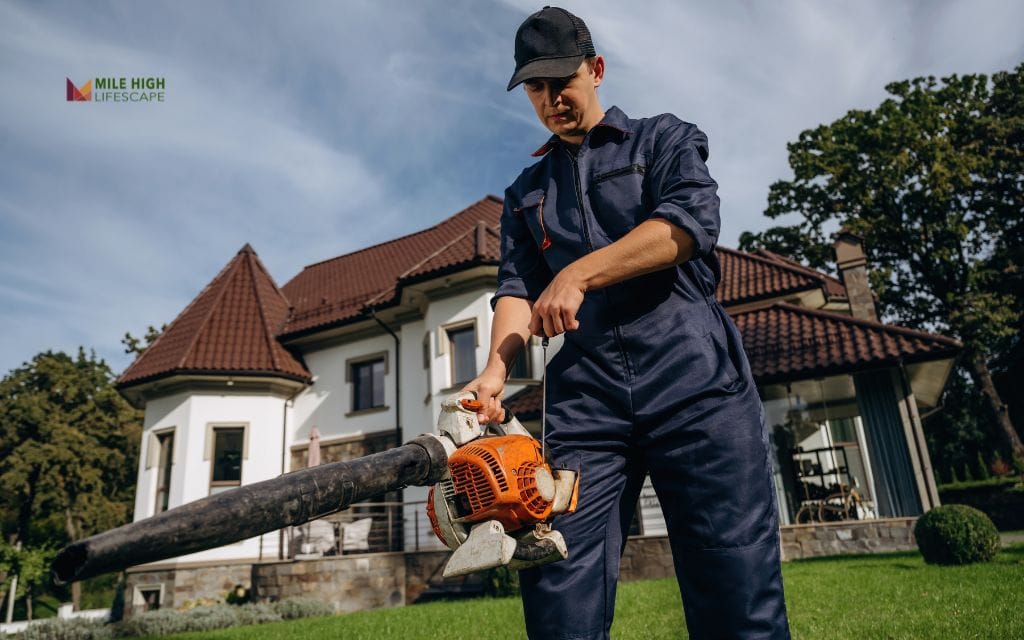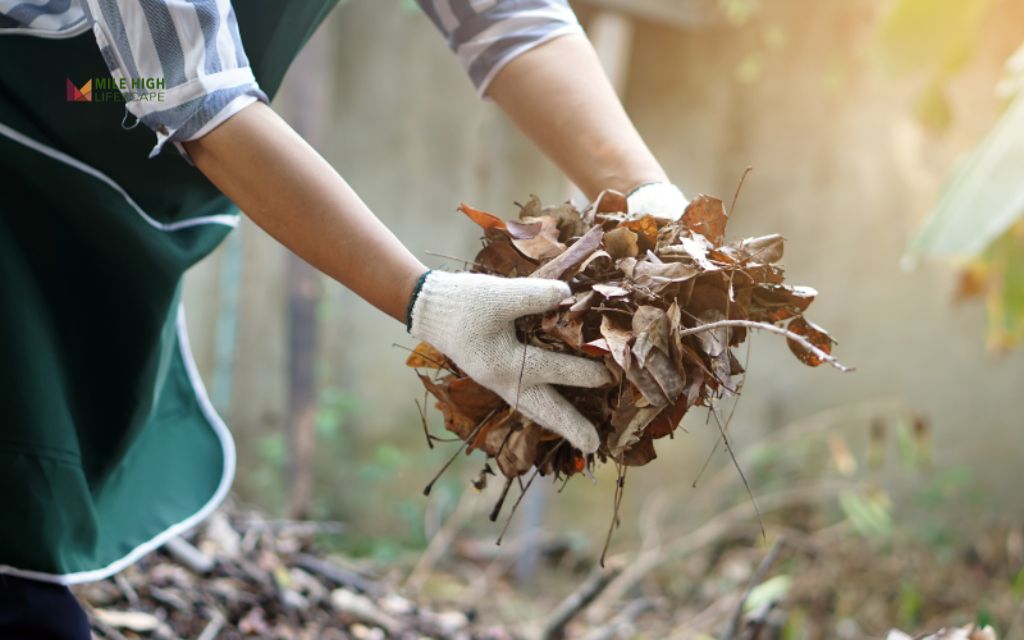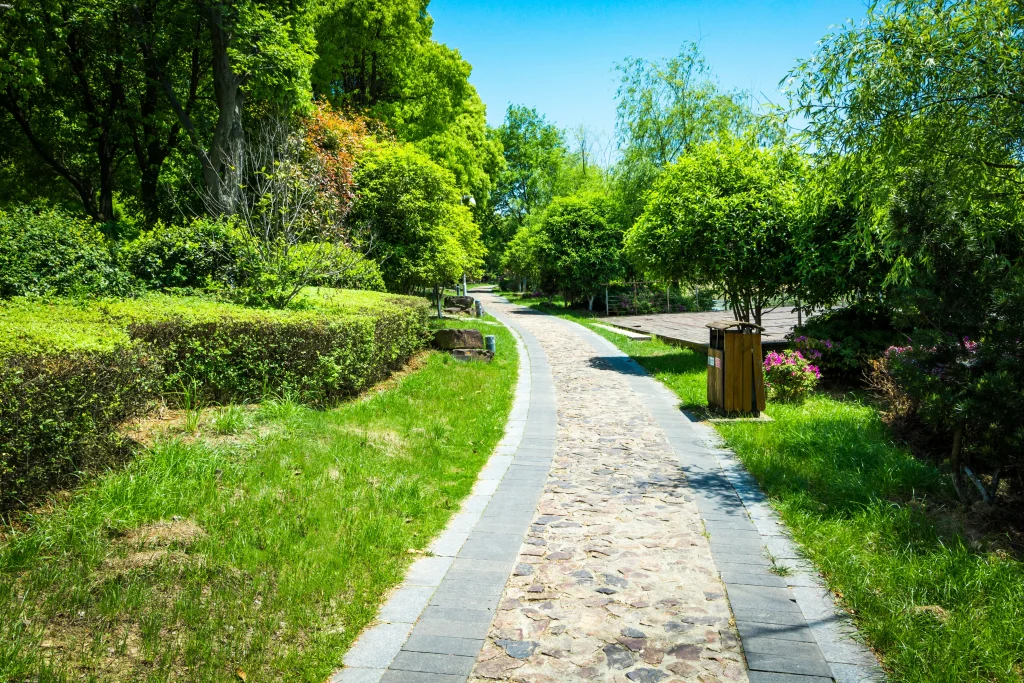Fall in Denver brings beautiful golden leaves and a not-so-beautiful cleanup challenge. When leaves pile up on your mulch beds, they trap moisture, invite pests, and block sunlight, suffocating your plants and ruining your landscape’s neat look. So, how do you get leaves out of mulch?
But here’s the good news: you can remove leaves efficiently without ruining your mulch layer. This process requires the right approach, tools, and timing to protect your investment in quality landscaping materials.
This guide shows you why leaf buildup on mulch creates problems, walks through 7 methods to get leaves out of mulch, and explains how to prevent future buildup in Colorado’s climate.

Why removing leaves from mulch matters
Prevents mold and fungal growth
When wet leaves mat down against your mulch layer, they create the perfect environment for fungal diseases that can spread to your plants.
Even in our typically dry climate, those early October snowfalls or heavy morning dew can turn leaf debris into a soggy breeding ground for mold.
Protects plant roots
Your plants need air circulation around their root zones to stay healthy. When leaves from bushes and trees pile up in mulch beds, they create an impermeable barrier that prevents gas exchange in the soil. This suffocation effect is particularly harmful to shallow-rooted perennials and can weaken even established shrubs going into winter dormancy.
Deters pests and rodents
Leaf piles provide cozy winter homes for mice, voles, and insects looking to escape Colorado’s harsh winters. These uninvited guests can damage plant roots, chew on bark, and create tunnels that destabilize your mulch beds. Getting rid of leaves promptly eliminates these attractive nesting sites before rodent populations settle in for the season.
Keeps mulch effective and aesthetic
You invested in quality mulch to protect your plants and enhance your property’s curb appeal. When leaves in mulch accumulate unchecked, they interfere with the mulch’s ability to insulate soil, regulate temperature swings, and suppress weeds. Plus, matted debris leaves simply look messy and diminish all your landscaping efforts.
7 easy methods to get leaves out of mulch
Use a leaf blower (on low power setting)
A leaf blower is the fastest way to remove leaves from mulch beds. The key is using variable speed settings to gently push leaves out without displacing your mulch layer.
How to do it:
- Set your blower to low or medium power
- Hold the nozzle at a 45-degree angle to the mulch surface, not pointing straight down
- Work in short bursts rather than continuous blowing
- Move from one end of the bed to the other
- Direct leaves toward a collection tarp or area for easy pickup
This method excels when you need to cover ground quickly. The limitation comes with fine mulch materials that can blow away with leaves.

Rake carefully with a leaf or shrub rake
Raking remains one of the most reliable methods for removing leaves, but tool selection matters tremendously.
Use a flexible plastic fan rake or specialized leaf rake, not a metal garden rake. Metal tines dig deep and displace mulch, while flexible plastic or bamboo rakes skim across the surface, collecting leaves without disturbing the mulch layer underneath.
Best practices:
- Rake in short, sweeping motions parallel to the mulch surface
- Apply gentle pressure
- Work in one direction to create manageable piles
- Perfect for bark mulch or heavier rock mulch beds where blowers might be too aggressive
The physical effort required makes this method slower than blowing, but the control you gain often justifies the extra time.
Pro Tip: Use a hand rake or mini shrub rake for tight spaces where full-sized tools can’t reach. These smaller tools give you precision control in crowded beds.
Use a leaf vacuum or mulcher vac
Leaf vacuums offer a two-in-one solution: they remove leaves from mulch and shred them for compost. Models like Toro Ultra or Worx Trivac offer adjustable suction settings specifically designed for delicate areas. The shredding function is particularly valuable if you want to reuse leaf debris as compost or soil amendment rather than sending it to the landfill.
Advantages:
- Precise control in tight spaces
- Reduces leaf volume by up to 16:1 through mulching
- Keeps work area cleaner than blowing
- Less physically demanding than raking for extended periods
Caution: Set suction to low when working with lightweight mulches like shredded cedar or small decorative bark to avoid vacuuming up your mulch along with the leaves.
Hand-pick (for flower or rock gardens)
Sometimes the best way to get leaves out of mulch is the old-fashioned way – by hand.
This method gives you complete control and zero risk of damaging tender plants, disrupting root zones, or displacing expensive decorative rock mulch. While it’s the most time-intensive approach, hand-picking is often necessary for high-value landscape areas.
Recommended tools:
- Heavy-duty gardening gloves
- Grabber tools or reachers for larger leaf piles
- Mesh scoops for collecting without disturbing mulch
- Garden kneeler or pad for comfort during extended sessions
Denver homeowners with small bed areas or limited budgets often find this the most practical solution. No equipment purchases required, just time and attention to detail.

Try a leaf blower + rake combo
The combination method leverages the strengths of both tools: speed from the blower and precision from the rake.
Start by using your leaf blower to push the majority of leaves out of mulch beds and into windrows or piles. Then follow up with gentle raking to remove stubborn leaves that got caught around plant stems or settled into mulch crevices.
This approach works great for:
- Beds with mixed mulch types (wood chips + compost blends)
- Areas with irregular terrain or slopes
- Large properties where pure hand-raking would take hours
- Situations where some leaves are wet and heavy while others are dry and light
Use a lawn vacuum or shop vac
A wet/dry shop vacuum with a brush attachment provides surgical precision for removing leaves in areas where traditional yard tools are too bulky or aggressive.
This method excels in:
- Narrow spaces between hardscaping and planting beds
- Decorative rock gardens where you can’t risk displacing stones
- Under low-growing shrubs and groundcovers
- Along fence lines and building foundations
Install a temporary leaf net or mesh barrier
Prevention beats cleanup when you can implement it effectively.
Before leaves drop, cover mulch beds with garden netting or landscape fabric. Once accumulation occurs, roll up the net and remove everything at once. This works particularly well under large maples, cottonwoods, and ash trees common throughout Denver neighborhoods.
The mesh allows water and air penetration while catching falling leaves on top. Your mulch stays clean underneath throughout the season. The time investment comes at installation, but you save hours during peak leaf drop.
This prevents leaves from sticking into moist mulch, where removal becomes more difficult.

When should you remove leaves from mulch
The timing of leaf removal affects both effectiveness and effort required. Denver’s climate creates specific windows when removal makes the most sense.
| Season | Action |
| Late October – November | Main cleanup after peak leaf drop |
| Early Spring (March – April) | Light refresh before new growth emerges |
| Post-snow melts | Remove matted leaves to prevent mold |
Don’t wait until spring – wet leaves can form mold layers that suffocate mulch and roots over winter.
Pay special attention after early-season snowfalls. When snow melts, any leaves underneath become waterlogged and mat down against the mulch, making them much harder to remove later. A quick cleanup after each snow event saves significant effort compared to dealing with compacted leaf layers in spring.
Pro tips for maintaining mulch during leaf season
Master these practices to minimize leaf cleanup hassles year after year:
- Keep mulch 2 – 3 inches deep: Too thick traps leaves and creates excessive moisture retention. Too thin allows leaves to settle directly on soil, making removal more difficult.
- Choose larger bark chips or rock mulch under deciduous trees: Easier to clean because leaves can’t wedge between larger pieces as easily as they do with fine shredded mulch. The rougher texture also allows better airflow underneath leaf layers.
- Edge beds to prevent leaf blowback: Install steel or plastic edging to create a defined barrier between lawn and mulch beds. This prevents wind from blowing leaves from turf areas back into your freshly cleaned beds.
- Consider mulching leaves directly into lawn areas: Use a mulching mower to chop leaves into tiny pieces that decompose quickly in grass. This returns valuable nutrients to your soil and reduces the volume of leaves you need to remove from landscape beds.
- Refresh mulch each spring: Even with careful removal techniques, you’ll lose some mulch each season. Adding a fresh 1-inch layer each April maintains proper depth and gives beds a clean, uniform appearance for the growing season.
Conclusion
Removing leaves from mulch doesn’t have to be a back-breaking fall chore.
With the right tools, timing, and local know-how, you can keep your beds tidy and your plants thriving through Denver’s seasonal swings.
The key is choosing the best way to get leaves out of mulch for your specific situation – whether that’s a quick pass with a leaf blower for large areas, careful hand-picking around delicate perennials, or preventive netting under heavy-dropping trees. Each method has its place in a complete fall maintenance strategy.
Don’t just remove – reuse. Compost or shred your leaves into nutrient-rich mulch for next season’s garden.
______________
Need help with fall landscape cleanup or mulch installation in Denver?
Mile High Lifescape offers comprehensive seasonal maintenance services throughout the Denver metro area, including leaf removal, mulch bed restoration, and yard waste solutions.
Our team knows exactly how to protect your landscape investment while keeping your property looking its best through every season.
Contact us at (303) 877-9091 or hello@milehighlifescape.com for expert guidance.
Frequently Asked Questions (FAQ)
Should I remove all leaves from mulch beds?
Not all. A light layer (less than 1 inch) can act as free mulch and provide additional insulation for plant roots. However, thick mats should be cleared to prevent suffocation, mold growth, and pest problems.
What’s the best way to get leaves out of mulch?
Use a blower on a low setting or flexible leaf rake for most situations. Avoid vacuums that may suck up bark mulch along with leaves. The best method depends on your bed size, mulch type, and how much time you have.
Can I use leaves as mulch?
Yes! Shred them first using a mulching mower or leaf shredder. They decompose faster and add valuable nutrients to the soil. Whole leaves tend to mat together and repel water, but shredded leaves create excellent organic mulch that improves soil structure. Mix shredded leaves with existing mulch in a 50/50 ratio for best results.
How often should I remove leaves during fall?
Every 1 – 2 weeks during the heavy drop season keeps mulch fresh and healthy. In Denver, plan for 3 – 4 cleanup sessions between mid-October and Thanksgiving.
Does wind make cleanup harder in Denver?
Absolutely. Tackle cleanup early morning or after sunset when the air is calm. Checking the weather forecast for low-wind days saves tremendous frustration and makes every cleanup method more effective.
